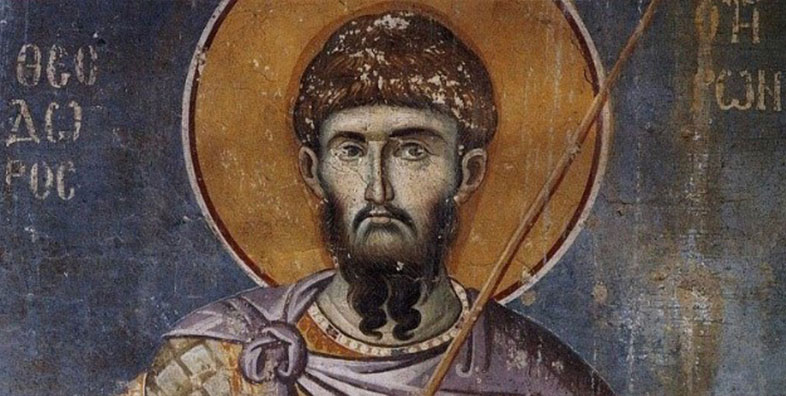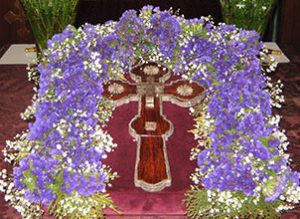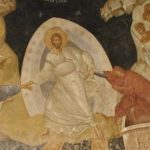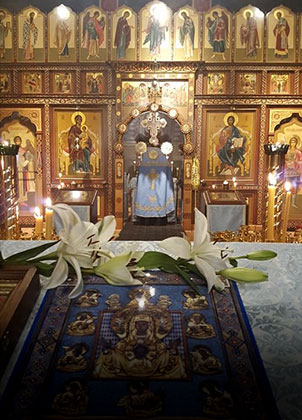HOLY GREAT MARTYR THEODORE THE RECRUIT
This holy, glorious Martyr of Christ came from Amasia in Pontus and was a Roman legionary at the time of Maximian’s great persecution (c. 303). He had been a Christian since childhood but kept his faith secret, not out of cowardice but because he had not yet received a sign from God to present himself for martyrdom. While his cohort was stationed near the town of Euchaïta (Helenopontus), he learned that the people of the district lived in terror of a dreadful dragon, which lurked in the surrounding forest. He realized that here was the quest in which God would show him whether the time had come to offer himself for martyrdom.

Going deep into the woods, he came upon an abandoned village whose only remaining occupant, a Christian girl named Eusebia, told him where the monster had its lair. He set off to find it, arming himself with the sign of the Cross, and when he confronted the roaring beast, he thrust his spear through its head and killed it.
Convinced that now, by God’s grace, he would be able to vanquish the spiritual dragon, the Devil, just as he had slayed the visible monster, Saint Theodore returned to the camp, ready to confess his faith.
When the commander of his cohort ordered a sacrifice to the gods of the Empire, Theodore remained in his tent. “I am a Christian,” he told the squad who came to look for him. “I adore only Christ. He is the King whom I serve, and to Him only am I willing to offer sacrifice!” After plying him with crafty questions, they left him in order to interrogate other Christian soldiers.
Inflamed with divine zeal, that night St Theodore went to the pagan temple and reduced the altar of Rhea, the mother of the gods, to ashes. He was caught in the act by a verger and brought unresisting to the governor Publius. There was an uproar in Euchaïta when the deed was known; but Theodore replied calmly to the governor’s questions, showing the absurdity of regarding as a deity a lifeless piece of wood which had been reduced to ashes in a few moments. Threatened with dire torments, the Saint responded, “Your threats do not frighten me because, amid torments, the power of Christ will be joy and gladness to me.” Grinding his teeth in rage, the governor had him thrown into a gloomy dungeon.
That night, Christ appeared to His valiant servant and promised that His grace would be at once his food and drink, his joy and shield. Thus comforted, Theodore spent his time chanting hymns with the Angels, so that even though his cell was bolted and barred, the jailers thought that other Christians must have joined him there.
When offered bread and water, Theodore refused it, saying that Christ had promised him food from heaven. On coming before Publius for the second time, he was offered the post of high priest of the idols, at which he laughed, and assured the governor that he was ready to be cut in pieces for the love of Christ.
He was then hung by his heels while his body was lacerated with iron claws. But faced with the Saint’s unconquerable resolution, the tormentors labored in vain, and the governor, fearing lest this example encourage other Christians, decided to be done with him; and he condemned him to be burned to death.
When they reached the stake, the Martyr took of his clothing and sent up a fervent prayer that God would strengthen the other confessors. He walked freely into the flames, which surrounded him but left him untouched as though wanting to do him obeisance. In the midst of this triumphal circlet, Saint Theodore gave back his soul to God with thanksgiving. The pious Eusebia ransomed his body, which she took to Euchaïta. A church was built there in honour of the Martyr, who obtained healing of soul and body for the many pilgrims who came to seek his intercession.
St. Theodore and the Miracle of the Kollyva
In 361, Julian the Apostate was doing his utmost to restore pagan customs. Knowing that the Christians were accustomed to sanctify the first week of Lent by fasting and prayer, the wily tyrant told the Prefect of Constantinople to have all of the food set out for sale in the markets sprinkled with the blood of animals sacrificed to the gods, so that no one in the city would escape the contagion of idolatry. However, the Lord did not abandon His chosen people, but sent His servant Theodore to outwit the tyrant. Appearing in a vision to Patriarch Eudoxius (360-364), the holy Martyr informed him of what was happening and told him to instruct the Christians not to buy food from the markets but instead to eat kolyva made from grains of boiled wheat. Thus, thanks to the intervention of the holy Martyr Theodore, the Christian people were preserved from the stain of idolatry. The Church has commemorated this miracle ever since on the first Saturday of Great Lent, in order to remind the faithful that fasting and temperance have the power to cleanse all the stains of sin.
СВЯТОЙ ВЕЛИКОМУЧЕНИК ФЕОДОР ТИРОН
Согласно житию, святой Феодор Тирон жил в начале IV века и был воином в городе Амасии Понтийской области, расположенной в Малой Азии у побережья Понта (Черного моря). Его прозвание Тирон идёт от воинского звания «молодой воин» (новобранец), – в отличие от святого великомученика Феодора Стратилата, почитаемого как покровитель православного воинства.

Во времена последних гонений на православную веру, по указанию императора Максимиана, проводилась кампания по принуждению христиан к принесению жертв языческим богам. Из Рима вышел Указ проверять и всех воинов на благонадежность.
Был организован целый ритуал ихпоклонения языческим богам. Феодор отказался проходить этот ритуал, поскольку был христианином. Он пришёл к своему военачальнику Вринку и сказал: «Не могу поклоняться идолам, поскольку поклоняюсь Христу». Начальник не стал притеснять верного воина, ответив: «Поступай, как сам знаешь».
Феодор вышел на улицу, где увидел целую вереницу солдат-христиан, ведомых с избиениями и оскорблениями в темницу, но не отрекшихся от Христа. Феодор стал их утешать, подбадривать и укреплять в вере. Жрецы же самодовольно говорили, что они всё равно искоренят христианство, и скоро останутся только одни их идолы, которым будет поклоняться весь, без исключения, народ.
Феодор решил опровергнуть это самодовольное заявление языческих жрецов и поджёг их храм Кибелы, наполненный языческими идолами. Храм сгорел дотла. Жрецы были поражены: как так мог моментально полностью сгореть столь величественный их храм со всеми идолами, казавшийся непоколебимым?! Жрецы поняли, кто это сделал и уговорили градоначальника Публия бросить Феодора в тюрьму и уморить голодом.
В темницу к Феодору, обреченному на голодную смерть, но не перестающему возносить свои молитвы к Богу, явился Сам Господь Иисус Христос, укреплял, и утешал узника. Феодор, вдохновляемый Господом, не умер от голода и продолжал проводить свои дни в молитвах, ещё сильнее укрепляясь в вере. Феодору вновь предложили совершить жертвоприношение, но он снова отказался. Мученика вывели из темницы и разными пытками принуждали отречься от Христа. Строгали его тело и железными зубцами, но Феодор продолжал исповедовать Христа. Мучитель, удивляясь такому мужеству и терпению святого Феодора, сказал ему:
— «Неужели ты, сквернейший из всех людей, не стыдишься уповать на Человека, названного Христом, Который Сам был казнён бесчестной смертью? Неужели ты ради Сего Человека так безрассудно подвергаешь себя мукам?» Христов мученик отвечал на это:
— Пусть выпадет на мою долю и на долю всех призывающих имя Господа Иисуса Христа такое же бесчестие!
Тогда народ стал кричать и требовать, чтобы скорее была совершена казнь над святым Феодором. Видя непреклонность мученика, правитель приговорил его к сожжению.
Святой Феодор сам бестрепетно взошел в пламень костра, не переставая возносить молитв ко Господу. И здесь, с молитвой ко Христу, предал свою душу Богу. Это случилось около 305 года. Так Феодора сожгли на костре. Его останки, по преданию, неповреждённые огнём, попросила христианка Евсевия и погребла в своём доме в городе Евхаитах, недалеко от Амасии.
Предание Православной церкви связывает с Феодором Тироном следующее чудо.
Через 50 лет после кончины святого Феодора император Юлиан Отступник (361-363 гг.), возжелал осквернить христианский Великий пост. В 362 году, желая посмеяться над христианами, Юлиан приказал градоначальнику Константинополя окропить в Великий пост все съестные припасы на рынках идоложертвенной кровью. Так он хотел вовлечь ничего не подозревающих христиан в языческое жертвоприношение и «уничтожить» все их великопостные подвиги.
Святой Феодор в ночном видении явился Константинопольскому архиепископу Евдоксию и велел ему объявить христианам, чтобы они не покупали на рынках оскверненные припасы и употребляли в пищу коливо (кутью), то есть вареную пшеницу с мёдом. В память об этом событии Православная церковь до сих пор ежегодно отмечает память великомученика Феодора Тирона в первую субботу Великого поста. Накануне, в пятницу, после литургии Преждеосвященных Даров читается молебный канон великомученику Феодору (составлен святым Иоанном Дамаскиным) и благословляется кутья, которая затем раздаётся верующим. В память об этом событии в Православии установлено празднование в честь святого Феодора Тирона, совершаемое в первую субботу Великого поста.









